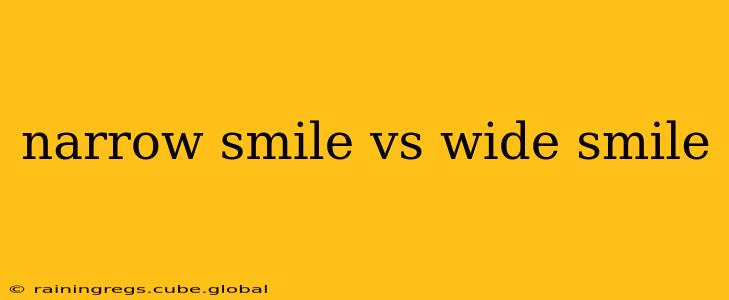A smile—it's a universal symbol of happiness, connection, and positivity. But did you know that even something as seemingly simple as a smile can communicate a surprising amount of information? The difference between a narrow smile and a wide smile, for instance, can reveal subtle nuances in emotion and intent. This exploration delves into the fascinating world of smiles, dissecting the differences and exploring what each might convey.
What is a Narrow Smile?
A narrow smile, often described as a "lip press," involves a slight upward curving of the lips, barely revealing any teeth. It's a more contained expression, often less intense and less outwardly expressive than its wide-mouthed counterpart. The muscles engaged are primarily those around the mouth, with minimal involvement of the cheek muscles or eyes.
Think of it as a polite, reserved, or even slightly guarded smile. It can be a social lubricant in formal settings or used when one feels uncomfortable, uncertain, or wants to appear polite without being overly enthusiastic.
What is a Wide Smile?
A wide smile is characterized by a significant upward turn of the lips, revealing a substantial portion of the teeth. This expression usually involves the engagement of the zygomaticus major muscles (cheek muscles), often causing the eyes to crinkle slightly at the corners—a genuine smile often includes this "Duchenne marker." It's a more expansive, outwardly expressive, and typically conveys genuine joy, happiness, and openness.
What's the Difference in Meaning and Interpretation?
The key difference lies in intensity and authenticity. A wide smile generally signifies genuine positive emotion, while a narrow smile can be more ambiguous. The context is crucial.
Narrow Smile Meanings:
- Polite or Formal: A subtle, narrow smile might be used in a professional setting or when interacting with someone you don't know well.
- Reserved or Shy: A person feeling shy or reserved might use a narrow smile to express politeness without full engagement.
- Concealment: A narrow smile can sometimes mask negative emotions or discomfort. It might be a way to appear pleasant while internally experiencing something else.
- Appeasement: In some contexts, a narrow smile can be a sign of appeasement or submission.
Wide Smile Meanings:
- Genuine Happiness: A wide smile is typically associated with genuine, heartfelt joy and happiness.
- Openness and Friendliness: It conveys approachability, welcoming others to connect.
- Enthusiasm: Wide smiles often indicate excitement and strong positive feelings.
- Trust and Vulnerability: The openness associated with a wide smile can suggest trust and a willingness to be vulnerable.
Does a Narrow Smile Always Mean Something Negative?
No, absolutely not. A narrow smile doesn't always indicate negativity or deception. As mentioned earlier, context is key. In a formal setting, a narrow smile might be entirely appropriate and even expected. The intensity and duration of the smile, along with other accompanying body language cues, are important factors to consider.
How Can I Tell the Difference Between a Genuine and a Fake Smile?
Observing the involvement of the eyes is crucial. A genuine smile, often called a Duchenne smile, involves the contraction of muscles around the eyes, causing crow's feet or wrinkles at the corners. A fake smile generally only involves the mouth muscles. Paying attention to the overall body language and the context of the interaction can also help distinguish genuine from insincere expressions.
Conclusion: The Power of Observation
The difference between a narrow and a wide smile might seem small, but it's a fascinating area of nonverbal communication. By understanding the subtle nuances of these expressions, we can better interpret the emotions and intentions of others, ultimately leading to more effective and empathetic interactions. Remember that observation should be coupled with understanding the context of the situation to avoid misinterpretations.
